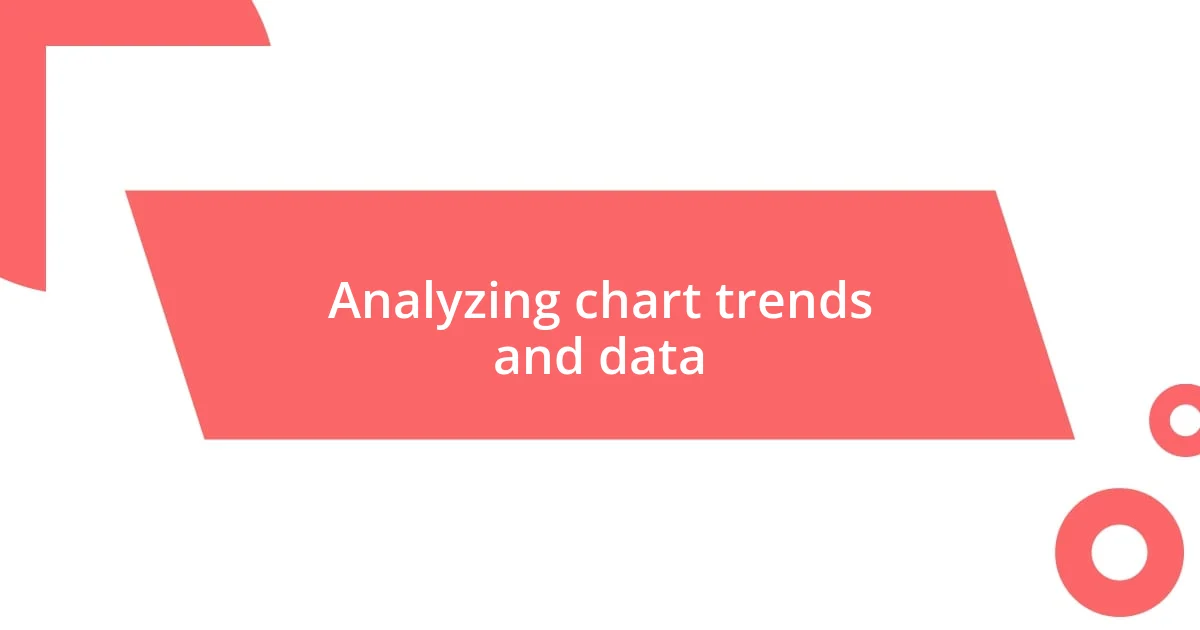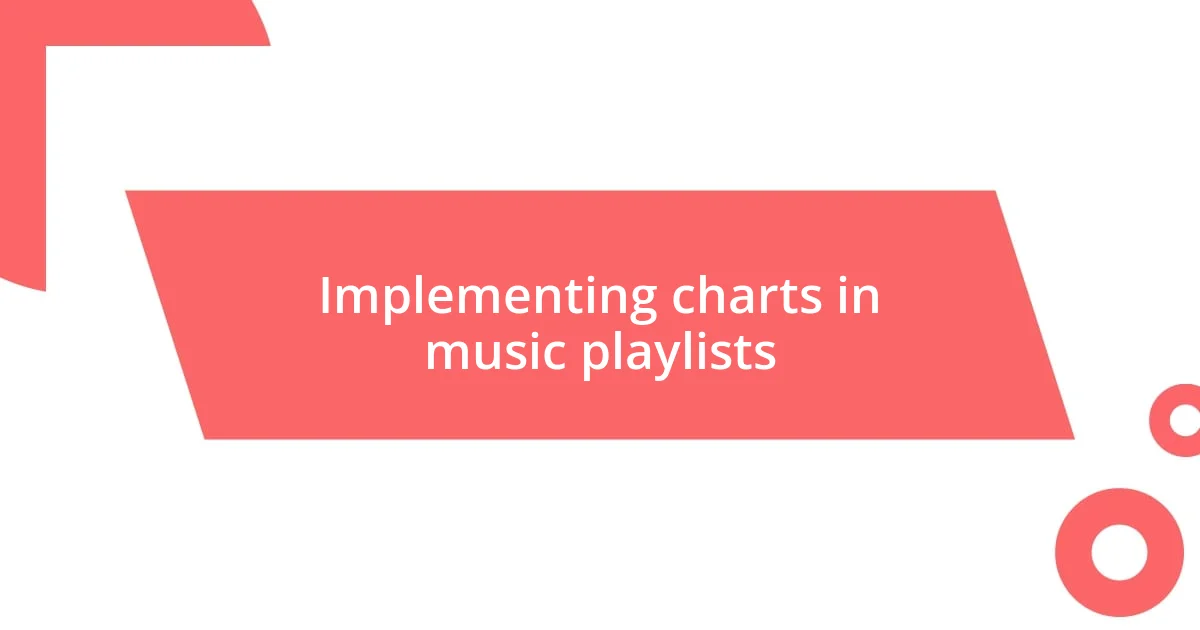Key takeaways:
- Charts provide valuable insights into current music trends and cultural shifts, helping listeners discover new artists and genres.
- Platforms like Billboard, Spotify, and social media play a crucial role in accessing and analyzing music charts, enhancing the exploration experience.
- Integrating chart data into playlists allows for a dynamic blend of new and classic tracks, enriching personal music experiences and creating memorable moments.

Understanding the importance of charts
Charts serve as a crucial window into the ever-evolving landscape of music, giving us a snapshot of what resonates with listeners at any given moment. I remember flipping through charts during my teenage years, feeling that immediate thrill when I discovered a new song that everyone seemed to be talking about. Have you ever experienced that rush of excitement when you find an artist before they hit it big? It’s like a secret handshake among music lovers.
They’re not just numbers; they reflect trends, cultural shifts, and the collective mood of society. I often find myself pondering how a song can rise or fall in popularity and what that says about us at that point in time. For instance, remember the sudden surge in interest for a particular genre? It’s fascinating to witness shifts that may even echo larger movements in the world.
Moreover, charts guide my listening habits, helping me curate playlists that are not only current but resonate with deeper themes I find compelling. Each peak and valley in a chart sparks curiosity, urging me to explore why certain tracks resonate. Have you ever glanced at a chart and felt compelled to dive into the entire discography of a suddenly trending artist? It’s like opening a treasure chest filled with hidden gems.

Finding popular music charts
Finding popular music charts can feel like a treasure hunt. I often start my journey by checking platforms like Billboard and Spotify. They not only showcase the latest hits but also provide context, like how long a song has stayed in the limelight. It’s refreshing to see where songs have landed and think back to my first listen of a track that has now climbed the charts. That moment of connection feels so rewarding, doesn’t it?
You’d be surprised at how many different charts exist! Each one brings its own flavor and perspective on music trends. For example, the iTunes chart may highlight an artist who’s rocking the charts in the U.S., while an international chart might reveal hidden talents from around the world. When I stumble upon these global sounds, I often find myself in a rabbit hole of discovering new artists. Have you ever looked at a chart from a different country and thought, “Wow, I need to know more about them!”
One of my favorite ways to find popular music charts is through social media platforms. These spaces often ignite discussions around rising stars or viral hits. A simple scroll through TikTok can yield fascinating insights; the charts don’t always capture the underground buzz around a song. When I encounter a track gaining traction on social media, I feel a thrill, as if I’m privy to a secret phase of discovery. The excitement in finding new tunes in such unconventional ways is part of what keeps my music exploration vibrant.
| Chart Source | Key Features |
|---|---|
| Billboard | Established rankings, detailed genre charts |
| Spotify | Real-time popularity, user-curated playlists |
| YouTube | Viral trends, music video views |
| Apple Music | Global hits, personalized recommendations |

Tools for accessing music charts
I rely on a variety of tools to access music charts that not only showcase what’s popular but also help me connect with the music community. Each platform has its unique features that enhance my discovery process. I remember the first time I stumbled across the Apple Music charts; I was amazed by how their personalized recommendations felt tailored to my taste, almost like having a friend curate music just for me.
Here are some key tools I use for accessing music charts:
- Billboard: Offers iconic charts across genres and provides historical context.
- Spotify: Provides real-time updates with insights into trending tracks and playlists created by other users.
- YouTube: Highlights the music video views, allowing me to spot viral hits in an engaging visual format.
- Apple Music: Combines global hits with tailored playlists to introduce me to new artists based on my listening habits.
- Shazam: Lets me identify songs on-the-go and explore related charts based on what’s trending from my surroundings.
Finding the right chart often feels like riding a wave of discovery—each platform sweeps me into different currents of music trends. For instance, I often refer to TikTok, not just for entertainment but as a true barometer of what songs are bubbling under the surface. I remember once seeing a dance challenge that instantly drew my attention to a catchy track I had never heard of before—it was exhilarating to experience a song’s rise in popularity while being part of that journey. There’s something incredibly gratifying about feeling that pulse of music culture, knowing you’re one of the first to acknowledge a hidden gem. Each click on these platforms adds another layer to my musical exploration.

Analyzing chart trends and data
Analyzing chart trends and data helps me uncover fascinating patterns in the music world. When I dive into data, I often focus on how long a song remains on the charts, which can indicate its staying power. For instance, I’ve noticed that some tracks linger for weeks, while others vanish quickly. This contrast makes me wonder—what is it about certain songs that captures listeners’ hearts and keeps them coming back for more?
As I sift through chart trends, I look for fluctuations that can hint at shifts in musical tastes. I’ve found that when I see a sudden spike in a song’s popularity, it often correlates with a viral moment, whether that’s a TikTok challenge or an intriguing performance on a popular show. Those moments always remind me of the time I bumped into a friend’s playlist featuring an artist just as they started gaining traction; it felt like being part of a musical revolution.
I also pay attention to genre trends over time. Observing how different styles ebb and flow provides me with a deeper understanding of the sonic landscape. For example, when I saw a resurgence in 90’s hip-hop on the charts, it sparked a wave of nostalgia and got me thinking about how cultural moments influence music trends. Have you ever revisited an old favorite only to discover it has made a comeback? There’s something magical about seeing that musical journey unfold through charts.

Using charts for genre exploration
Exploring genres through charts is like opening a treasure chest of sound. I often find myself venturing into less familiar territories simply by checking out trending tracks in a specific genre. For example, when I first explored indie rock, I was captivated by a song that had just hit the charts, and it led me down a rabbit hole of artists I’d never heard of before. It’s exhilarating to see how one chart-topping song can act as a gateway into an entire genre.
I’ve realized that music charts don’t just reflect popularity; they reveal cultural shifts and emerging sounds. One time, while examining the charts, I noticed a surge in journal-style rap tracks. It got me thinking—what stories are these artists trying to tell? This piqued my curiosity and nudged me to explore more about the individual artists and their inspirations. I remember delving into a documentary about one of those artists and feeling a deep connection to their journey, which music charts had introduced me to.
In my experience, genre exploration through charts feels like conversing with a diverse community of artists. When I listen to a playlist that includes both pop and alternative tracks, it inspires me to appreciate the nuances of sound. Have you ever found a favorite song that unexpectedly blends genres? I once stumbled upon a track that mixed jazz with hip-hop, and it was a revelation, reminding me of the endless possibilities within music. Charts serve as a brilliant map, guiding me to discover the richness and diversity of musical expression.

Discovering new artists through charts
I’ve discovered countless new artists by simply scrolling through music charts. I remember one afternoon when I stumbled upon a bubbling indie-pop artist who had just broken into the top 10. The catchy melody caught my attention immediately, and after diving deeper, I found a whole album that not only resonated with me but also opened my eyes to an entire wave of under-the-radar musicians. Isn’t it thrilling to find a gem that feels like it was made just for you?
Looking at artist collaborations can also be a goldmine for discovering new talent. I still remember the excitement when I first heard a collaboration between a well-known pop star and an emerging rapper. This unexpected pairing ignited my curiosity, leading me to explore the rapper’s entire discography. Those moments make me wonder—how often do we miss out on incredible music because we stick to what’s familiar? Charts can serve as a bridge to connect those diverse sounds.
The thrill of discovering an artist through charts creates a sense of community among fans. For instance, after noticing a fresh singer-songwriter making waves, I joined online discussions where everyone was buzzing about their music. It felt like being part of an insider’s club! Those conversations often lead to recommendations for even more hidden talents, setting the stage for musical adventures that I hadn’t anticipated. Have you ever felt that electric vibe when sharing a newfound artist with friends? It’s moments like those that remind me of the genuine joy music can bring into our lives.

Implementing charts in music playlists
When I curate playlists, incorporating charts gives me a pulse on what’s trending and what resonates with listeners. Recently, I crafted a playlist for a road trip, and using the charts, I picked songs that were not only up-and-coming hits but also included tracks from artists I hadn’t given much thought to before. There’s something exhilarating about blending familiar classics with fresh tunes—wouldn’t you agree that this mix often becomes the soundtrack of our lives?
Integrating charts into my playlists also helps me create a narrative through music. I recall putting together a chill evening playlist, and as I browsed the charts, I stumbled upon a mellow electronic track that was gaining traction. Adding it transformed the mood entirely, weaving in a contemporary vibe that perfectly complemented the classics I had chosen. Have you experienced that moment when a new song unexpectedly shifts the entire atmosphere of a gathering?
I also use charts to track seasonal trends and thematic playlists. For example, during the summer, I love curating a vibrant playlist full of upbeat tracks that reflect the energy of the season. I once added a song that had just bubbled up the charts, and its infectious vibe made us all hit the dance floor impromptu! It’s magical how a chart-topping song can energize a moment—what’s your go-to summer anthem that brings back memories of sun-drenched days?















